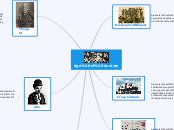
Age of Anxiety

Postwar Impact
Students will connect questioning of norms and reality to traumatic events in the early 20th century
Assessment: Students will complete a formative warm-up reviewing the condition of the Western World in 1920
Teacher writes a question on the board (or displays it from the projector)
Students spend a few minutes mentally reviewing prior knowledge
Students are called on to briefly explain their answers orally
Assessment: Students will complete a “hyper-doc” of online guided notes pertaining to information in readings and in instructor presentations
Teacher’s lectures reference how World War I and other events led to questioning of reality
Teacher notes how developments such as film and still photography meant a lack of need for expressing realism
Students will complete exercises (such as the film/music fill-in-the-blank) pertaining to those ideas
Students will learn new vocabulary words (abstract, absurd) pertaining to those concepts
Assessment: Students will orally answer questions in class
Teacher calls on students at strategic points during his lecture
Students answer both lower-level and higher-level questions tying in facts and concepts to the existing framework of World War I and the flu pandemic, introduced in the previous unit

Cross-Cultural
Students will note the circumstances that brought European trends in philosophy and the arts to the United States, and economic trends that made the Great Depression a global crisis
Assessment: Students will complete a “hyper-doc” of online guided notes pertaining to information in readings and in instructor presentations
Teacher lecture will include some developments in the Americas (Frida Kahlo, George Gershwin) parallel to developments in Europe
Students complete exercises in their hyperdocs pertaining to the cultural exchange between Europe and the Americas in this period
Assessment: Students will complete 6-C document analyses of primary sources pertaining to the Great Depression and the Weimar crisis
Instructor models successful completion of document analysis
Students close-read primary sources
Students answer questions pertinent to said primary sources
Students identify content, context, citation and other parts of the 6 Cs

Summing It Up
Students will marshal analysis of trends in the interwar period to answer an essay question
Assessment: Students will complete an essay question identifying the three most important developments during the Age of Anxiety
Instructor assigns a prompt with a rubric
Students outline essay
Students write essay
Essay will be graded against the rubric

Thought
Students will understand and state the significance of developments in philosophy, psychology, literature and the hard sciences in the period 1900-1945
Assessment: Students will complete a foldable on significant figures in psychology, literature and the hard sciences in the period 1900-1945
Teacher will guide students through the readings, adding in supplemental information and reviewing key vocabulary words
Teacher provides a sample foldable
Students will read the textbook
Students will identify important facts and place them in the foldable

Arts
Students will understand and state the significance of developments in art, music, architecture and film in the period 1900-45
Assessment: Students will complete a “hyper-doc” of online guided notes pertaining to information in readings and in instructor presentations
Teacher lectures on developments in art (expressionism, Cubism, surrealism), architecture (International style/Bauhaus), music (12-tone, jazz) and film (Chaplin, Eisenstein)
Using their hyperdocs, students answer questions about key terms in art and architecture
Using their hyperdocs, students complete a fill-in-the-blank exercise about music and film
Using their hyperdocs, students identify three works of art and explain their characteristics and how each makes them feel
Assessment: Students will orally answer questions in class
Teacher calls on students at strategic points during his lecture
Students answer both lower-level and higher-level questions about art, architecture, music and film

Economics
Students will compare and contrast the Great Depression with eras before it and after it
Assessment: Students will complete 6-C document analyses of primary sources pertaining to the Great Depression and the Weimar crisis
Instructor models successful completion of document analysis
Students close-read primary sources
Students answer questions pertinent to said primary sources
Students identify content, context, citation and other parts of the 6 Cs
